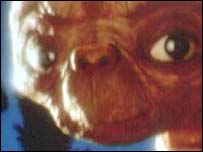
Why we are not like ET
BBC News Online science

Samples of DNA taken from humans, animals, plants, microbes and viruses have one thing in common: they form a double helix structure held together by four different chemicals called bases.
And scientists from New Zealand and Sweden have now built a computer model to show that organisms are unlikely to evolve if their "life code" is written using more or fewer bases.
The work could help our understanding of what to expect from alien lifeforms - if we ever come across them.
Copying errors
Reading along the double helix, the sequence of the bases can be read off as a genetic code made of four letters - A for adenine, C for cytosine, G for guanine and T for thymine.
This code carries the instructions for creating and maintaining life, but why not use two letters, or six or eight?
ET in the famous Spielberg film was said to have six-base DNA and, on the face of it, Earth-bound life could have, too.
The reason why not turns out to be in the way a prehistoric relative of DNA began to protect itself against copying errors.
Paul Gardner, and colleagues at Massey University, New Zealand, and Uppsala University, Sweden, used a computer model to try to explain why four turned out to be the magic number.
Evolution by supercomputer
It is not entirely clear how life first began on Earth, but many biologists believe that before our current DNA-dominated world, there was an environment known as RNA World.
RNA is a similar chemical to DNA but it is much less stable and so much less suitable for holding the blueprint information for building complex organisms.
Supporters of the RNA World theory believe that RNA evolved from simpler chemicals and only later evolved into DNA.
RNA would have existed in a constantly changing and reactive soup.
Gardner and his colleagues built a computer model to show how RNA in RNA World would have evolved into DNA.
Getting stuck
They instructed their supercomputer to examine how RNA might have developed had it had two, six or eight bases, as well as the standard four.
They found that four- and six-base RNA molecules were the most efficient at evolving into DNA.
But four-base RNAs were the ones which were best suited to overcoming RNA's fundamental weakness: its susceptibility to making errors as it copies itself.
The two- and eight-base RNAs seem to get stuck somewhere along the evolution process, Gardner told BBC News Online.
But six-base RNAs could have survived if they had evolved a way of putting right the errors introduced by mutation.
Alternative scenarios
The research poses the question of what kind of DNA extra-terrestrial life might have if a similar process of evolution had taken place on a similar planet elsewhere in the Universe.
"We found the margins between four- and six-letter alphabets to be low, so a percentage of independent lifeforms might incorporate six, or a different four.
"But it is likely that the same principles that life on Earth are based on will be used elsewhere," Gardner said.
If RNA-based lifeforms on other planets had developed the error-correcting techniques needed to repair the damage to their genetic code caused by mutation and degeneration, they may well have developed into something with six-base DNA.
"I'd love to meet an organism with a six-letter alphabet. However, they'd probably take a lot longer to sequence," he said.
人間、動物、植物、微生物、ウィルスから採取したDNAのサンプルには共通点があります。それは、彼らが”塩基”と呼ばれる4つの異なった化学物質によって結合された二重螺旋構造を形成していることです。
そして現在、ニュージーランドとスウェーデンの科学者たちは、より多く、またはより少ない塩基を使って”ライフ・コード”が書き上げられた時に、生物は予期せぬ進化を遂げることを示すためのコンピューターモデルを造りました。
それ(コンピューター・モデル)は、地球外生命体に対しての我々の理解を手助けすることになるかもしれません。もしも、私たちが彼らと偶然にも出会えたならですが・・・。
□誤りをコピー
二重螺旋に沿って読んでみると、塩基配列は4文字の遺伝情報として読み取ることができます。<A=アデニン、C=シトシン、G=グアニン、T=チミン>。
このコードが生命を創造、維持のための指示を伝えます。では、なぜ2文字、6文字または8文字でないのか?
ET(スピルバーグの傑作)は、6塩基のDNAを持っていると言われていて、見かけ上では、地球行きの寿命も持っているかもしれません。
上記のように判定する理由は、有史以前の親類(祖先)のDNAが誤りをコピーしないための自己防衛を始めたことです。
ポール・ガードナーと、ニュージーランドのマッシー大学、スウェーデンのウプサラ大学の同僚たちは、コンピュータモデルを使用して、なぜ”4”が重要な数字であるのか説明しようとしました。
□スーパーコンピューターによる発展
どのようにして地球上に生命が誕生したのか、ということは全てが明らかになっているわけではありません。しかし、多くの生物学者は、RNA(リボ核酸)の世界として知られている環境が、現在のDNAで支配された世界の前に存在したと信じています。
RNA(リボ核酸)はDNAと同類の化学物質ですが、とても不安定で、複雑な生物を造るための設計図を保持するには不適当です。
「RNA World理論」の支持者は、RNAが比較的単純な化学物質から発展して、後でDNAに発展しただけであると信じています。
RNAは、絶えず変化する反応性が大きい”スープ”の中に存在していたでしょう。
ガードナーと彼の同僚は、「RNA World」のRNAがどうDNAに発展したのかを示すためにコンピュータモデルを造りました。
□立ち往生
彼らは、標準の4と同様に、2、6または8個の塩基ならばRNA(リボ核酸)がどう展開したかを調べるようにスーパーコンピュータに命令しました、。
4塩基と6塩基のリボ核酸分子が最も効率的にDNAへと発展することを発見しました。
4塩基のRNAがRNAの根本的な弱点(自分自身をコピーした時にエラーを造ることに敏感であること。)に打ち勝つのに最も良い適していたものでした。
2と8塩基のRNAは発展の過程で立ち往生するように思えます。(ガードナーがBBC News Onlineに言った)
とはいえ、突然変異によって導入されたエラーを直す方法を発展したなら、6塩基のRNAは生き残ることができたでしょう。
□代替案
この研究が提起するのは、宇宙空間において同様の進化の過程が類似した他の惑星で行われたなら、地球外生命体はどのような種類のDNAを持っているのかという疑問です。
「私たちが、4文字と6文字のアルファベットの間のマージンが低いのがわかったので、独立生物の割合は6、または異なった4を取り入れるかもしれません。」
「しかし、地球上の生命が基づいている原則と同じ原則がどこか他の場所で使用されていることは、あり得ることです。」と、ガードナーは言いました。
他の惑星のRNAベースの生物が、(突然変異と退化によって引き起こされた遺伝情報への損害を修理するのに必要な)エラー修正技術を発展させていたなら、それらの生物は6塩基のDNAで発展したことでしょう。
「6文字のアルファベットの生物に会いたいと思います。しかしながら、彼らはたぶん配列に膨大な時間がかかるでしょう。」と、彼は言いました。